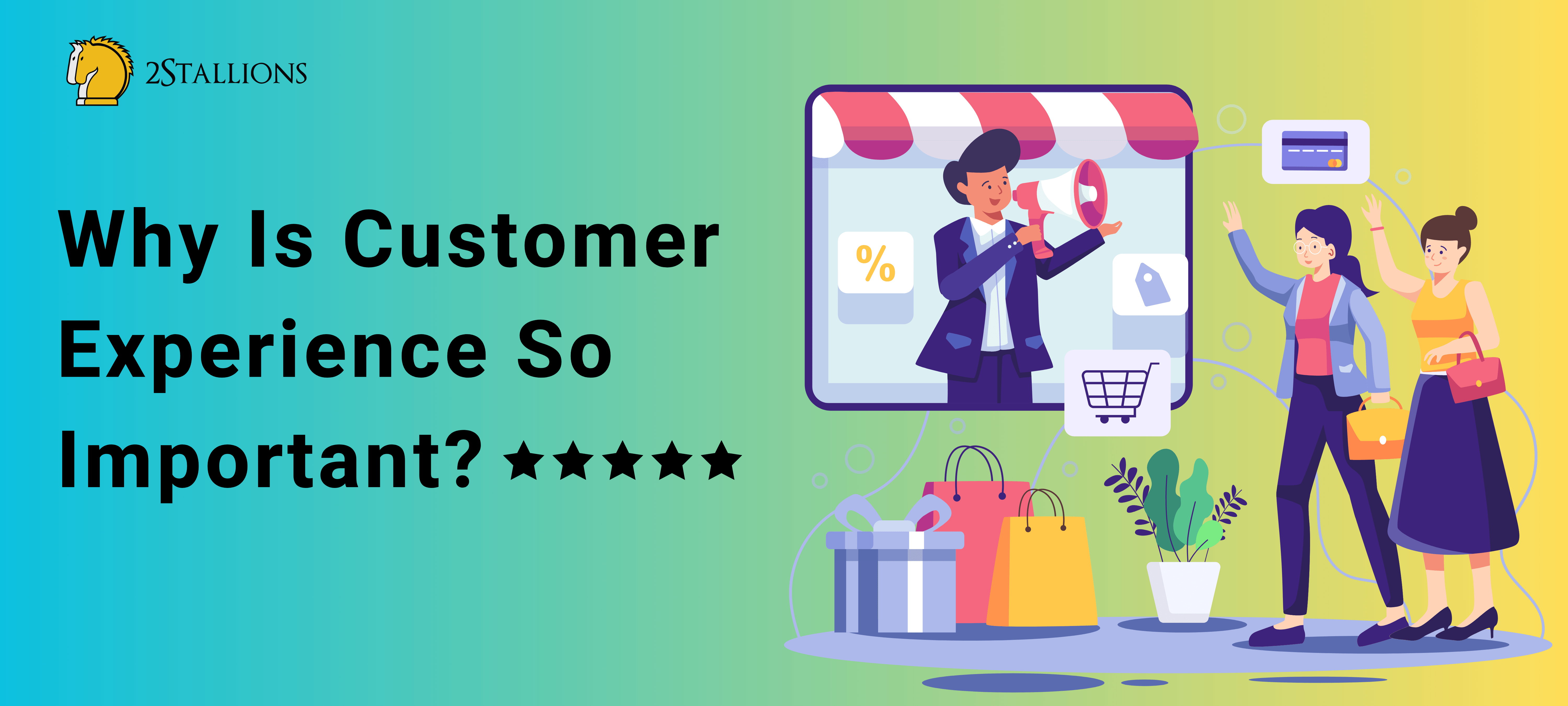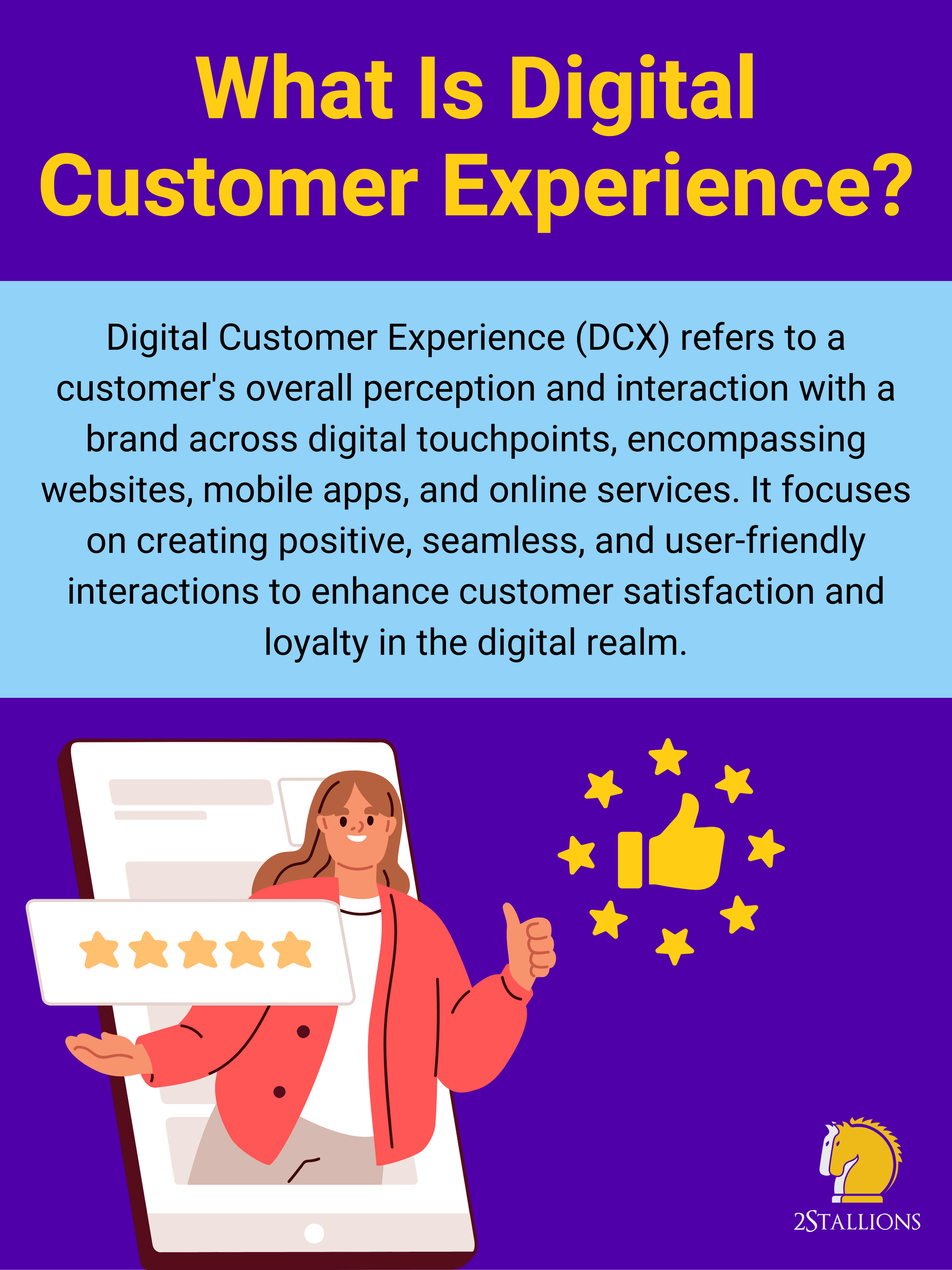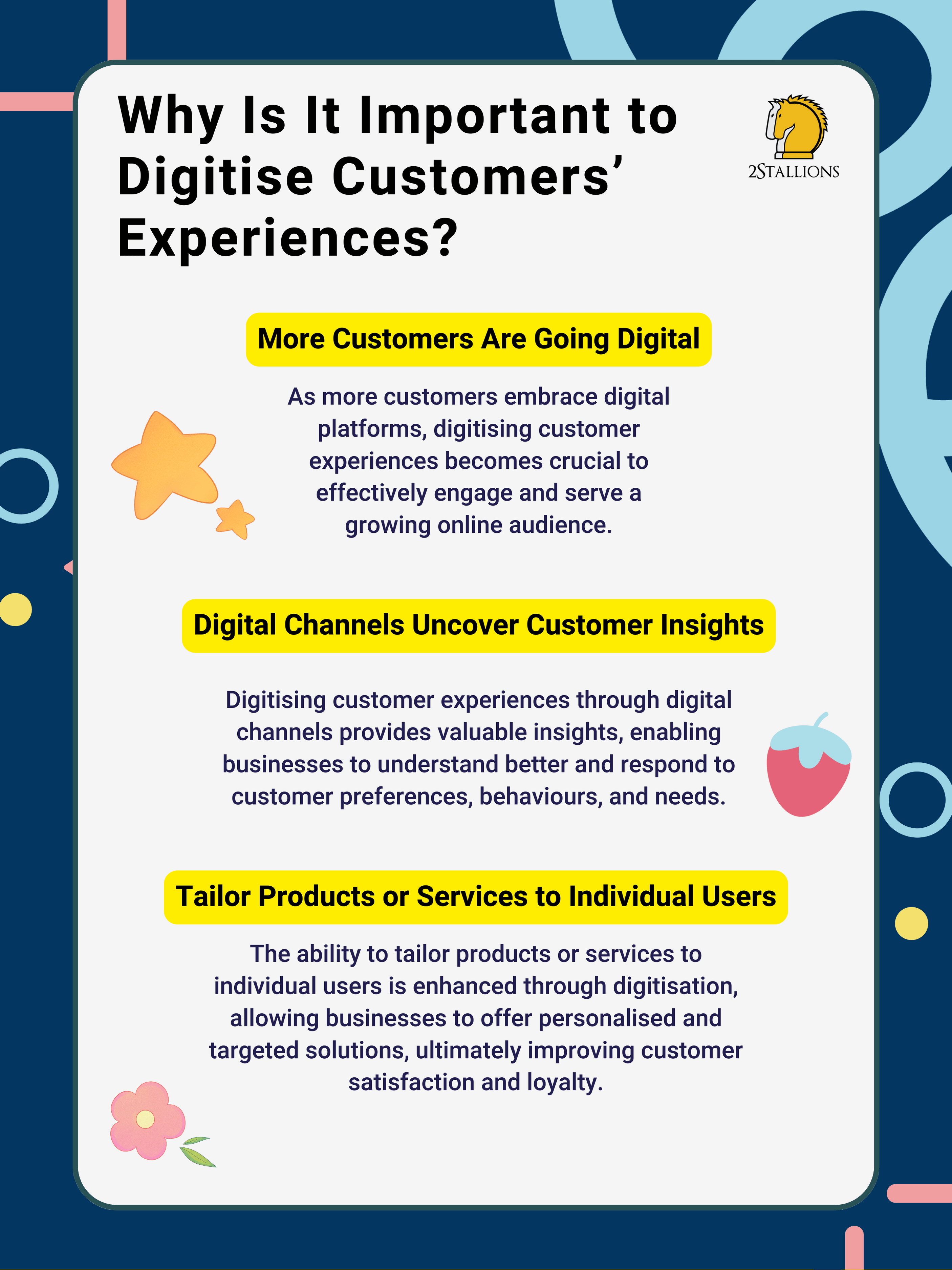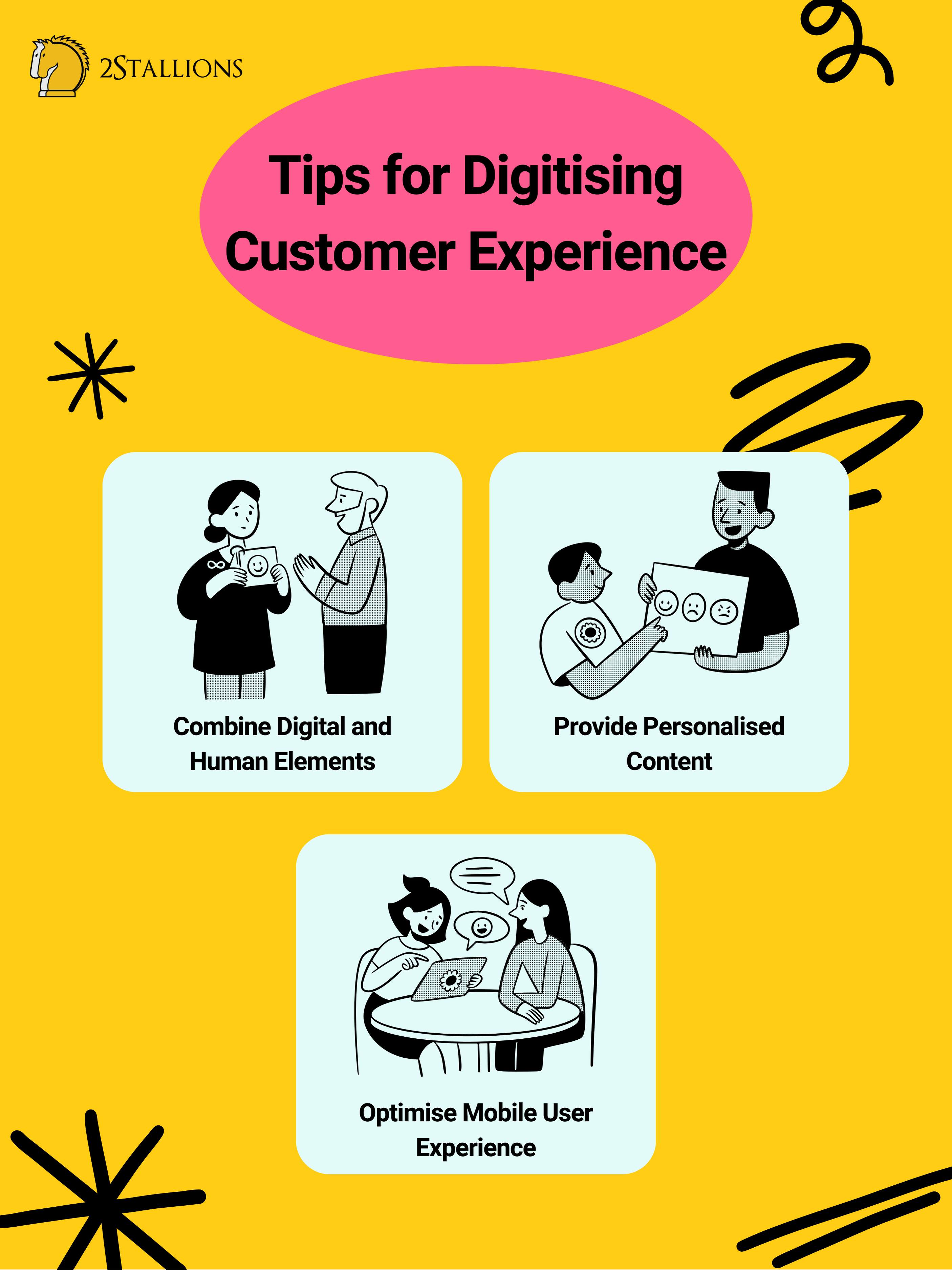Content
SHARE

The COVID-19 Pandemic hit us all hard and drove many businesses – and individuals! – online. As a result, we’ve witnessed a profound transformation in consumer behaviour, with more people now relying on the web to search for products and services, make online purchases, and transact with e-retailers. This shift towards the digital realm has given rise to the imperative of digital experience management, enhancing the digital customer experience, and online customer experience optimisation.
[thrive_leads id=’8354′]
In this digital world, where every click, scroll, and online action is essential, companies need to change and improve to satisfy their customers who use digital tools. Digital customer experience management is the key to success in modern business. The new market reality encourages businesses to step up their marketing initiatives and take advantage of digital media channels like websites, social media platforms like Facebook, and Instagram, video-sharing platforms like YouTube, and more.
What Is Digital Customer Experience
Digital Customer Experience, often called DCX, is a pivotal aspect of digital customer experience management. It revolves around how customers engage with a brand online, shaping their perceptions and actions during interactions. These interactions encompass various activities, such as seeking information, comparing products, inquiring about a product, and, most significantly, purchasing.
It’s essential to distinguish DCX from the in-store experience. In a physical store, factors like store aesthetics, the quality of customer service, safety, and product display profoundly influence the customer’s satisfaction. Several factors play a substantial role in determining your experience and whether you decide to purchase. These factors encompass the aesthetics and speed of a website, mobile compatibility, ease of navigation, language usage, and the reliability of information provided.
Unlike the warm welcome from a friendly store clerk when you enter a physical store, replicating this warmth online can be challenging. Thus, your website’s design and user experience are crucial components of digital customer experience management, ensuring that your customers have a pleasant time while browsing your products and services, even without a friendly face. Digital customer experience strategy and customer experience optimisation are key elements in crafting a successful online presence aided by digital customer experience analytics.
Why Is It Important to Digitise Customers’ Experiences?
A fundamental question arises: Why is digital experience management so vital? The answer is clear: As more businesses migrate to the online sphere, the competition has intensified, with customers readily navigating between websites.
To distinguish your brand and ensure customer satisfaction, prioritising an exceptional digital customer experience is imperative. This necessitates a well-crafted digital customer experience strategy meticulously designed to elicit visitors’ desired feelings and actions to your website or online platforms. The objective is to create a digital customer experience that leaves individuals not just content but eager to return for more. Digital Customer Experience (DCX) is a pivotal focus championed by forward-thinking businesses in online commerce.
1. More Customers Are Going Digital
Customers seamlessly adapt to technological advancements and evolving market dynamics. Their motivation isn’t driven solely by the fear of missing out (FOMO) but by the pursuit of convenience and fulfilment of their needs. Consider the realm of online commerce, where online shopping has overtaken traditional in-store purchases in terms of convenience. Mobile apps and eCommerce websites have enabled customers to shop for virtually anything from their homes, using devices ranging from desktops and laptops to tablets and smartphones. Customers value time efficiency, a lack of sales pressure, and discreet shopping experiences. Moreover, they have become increasingly discerning in their purchasing decisions. Businesses that fail to meet these expectations risk losing not only customers but their trust and loyalty. Salvation lies in alternative digital platforms for those unable to establish a full-fledged eCommerce website. Platforms like Instagram’s shopping feature and other social commerce tools offer excellent avenues to promote brands and engage with customers. Social media advertising campaigns can further amplify marketing efforts and drive sales.
2. Digital Channels Uncover Customer Insights
Nowadays, customers encounter more ‘clicks’ and fewer ‘bricks.’ Surprisingly, the absence of in-person interaction doesn’t hinder businesses; it enables them to harness customer data more swiftly than traditional methods without the bricks of communication by a third party. Web performance, for instance, can be scrutinised using digital customer experience analytics tools like Google Analytics (GA). Marketers can meticulously study website activities through web analytics tools, gaining invaluable insights into customer behaviours.
Key digital metrics businesses should leverage to foster a positive digital customer experience include:
-
Traffic:
The total number of site or page visits in a given time.
-
Page View:
The total number of pages viewed includes repeated views of a single page.
-
Unique Page Views:
The number of visitors who have viewed a specific page at least once during a visit.
-
Average Time on Page:
The average time users spend viewing a specific page or screen or set of pages or screens.
-
Bounce Rate:
The percentage of single-page visits or the number of visits people left your website from the same page they visited.
Provides insights on the above metrics. The tool can tell what path site visitors or users take, how long they stay on a specific web page, what actions they take during the visit, and more.
3. Tailor Products or Services to Individual Users
Digital transformation transcends technology; it hinges on the capacity to harness technology’s potential for crafting personalised customer experiences. As businesses integrate digital technology into their operations, they gain the ability to cater to each facet of the customer journey. Advanced data collection and analysis empower marketers to implement personalised approaches to customer needs. Personalisation stands as a cornerstone of delivering a meaningful digital customer experience. It serves as the final flourish that secures sales and nurtures brand loyalty.
Bonus: Tips for Digitising Customer Experience
1. Combine Digital and Human Elements
The rise of virtual customer assistants (VCAs), such as chatbots, is remarkable. These messenger bots are gaining popularity as they can efficiently automate customer inquiries while facilitating digital customer experience analytics and personalised interactions. H&M is a prime example of a company that has successfully intertwined digital and human elements. The multinational clothing retail giant utilised a chatbot to provide users with technology tailored to their needs and establish a highly personalised human connection.
2. Provide Personalised Content
Thanks to digital customer experience analytics capabilities, developing a content strategy that caters to customers’ interests and purchasing behaviours has become straightforward. Businesses can share various types of content like landing pages, social media posts, blogs, newsletters, and infographics, all precisely targeting their audience by leveraging available data.
3. Optimise Mobile User Experience
With the ever-growing global mobile population, optimising the digital customer experience strategy for mobile users is imperative. Variations exist in mobile usage statistics across studies, but the one constant is the continuous expansion of the mobile user base. People worldwide own smartphones and utilise them for various purposes, including shopping.
To excel in customer experience optimisation, businesses should consider these strategies to enhance the mobile user experience:
- Keep layouts simple
- Use easy-to-read text
- Aim for a responsive web design
- Use faster-loading image formats
- Improve the search feature in the app
As the world becomes increasingly digital, the need for pairing digital tech with a solid marketing strategy also increases. Brands should treat customers’ online journey as critical and find ways to deliver optimum digital customer experience. If you are thinking about developing a digital customer experience strategy, 2Stallions Digital Marketing Agency in Singapore can help lay the foundation so you can make the most out of digitisation. We offer the right mix of digital marketing services, including SEO (search engine optimisation) services, social media marketing, content marketing, and more. Contact us today to find out how you can further improve all your digital marketing efforts.
Elevate Your Online Presence With Our Expert Digital Content Marketing Services. Boost engagement, drive traffic, and convert leads with our tailored strategies. Discover the power of content marketing today! Click here to explore our Content Marketing services.
Originally published: 28 January 2021
Updated: 17 October 2023
Frequently Asked Questions about Digital Customer Experience
What Is An Example Of An Excellent Digital Customer Experience?
A prime example of an excellent digital customer experience is when a customer visits an e-commerce website and finds the interface easy to navigate, the product descriptions informative, and the checkout process smooth and efficient. The website also offers personalised product recommendations based on the customer’s past purchases and preferences, making the shopping experience convenient and tailored to their needs.
What Makes An Excellent Digital Customer Experience?
Several vital elements characterise a good digital customer experience. Firstly, it should be user-friendly, with an intuitive interface that is easy to navigate. Secondly, it must be efficient, ensuring customers can quickly find the information or products they seek. Personalisation is crucial, as customers expect tailored recommendations and content. Practical customer support, responsive to inquiries and issues, is a cornerstone of an excellent digital customer experience. Lastly, security and trust are essential, as customers need to feel confident that their data is protected when interacting with digital platforms.
What Is The Difference Between Customer Experience And Digital Customer Experience?
Customer experience (CX) encompasses all customer interactions with a brand, offline and online. It involves every touchpoint and impression the brand creates, from in-store experiences to website interactions. On the other hand, digital customer experience (DCX) focuses on online customer interactions. DCX is concerned with the quality of the customer journey within digital channels, such as websites, mobile apps, and social media. While CX is broader, DCX is a subset significantly shaping the overall customer experience.
What Are The Stages Of The Digital Customer Experience?
The digital customer experience typically consists of several stages. It begins with the customer’s initial interaction with a digital platform, such as a website or mobile app. This is followed by the exploration and navigation phase, where customers search for information or products. The next stage involves the selection of items or services, leading to the checkout process. After the purchase, there is the post-purchase phase, which includes order tracking, support inquiries, and feedback. Lastly, the ongoing relationship stage involves retaining the customer’s engagement and trust through personalised recommendations, content, and continued support.
What Is An Example Of A Digital Customer?
A digital customer is an individual who engages with a brand or business primarily through digital channels. An example of a digital customer is someone who shops online, makes mobile app purchases, interacts with a brand’s social media profiles, or subscribes to an email newsletter. These digital interactions allow the brand to collect data and insights, personalising the customer’s experience and offering tailored products, services, or content based on their preferences and behaviours.















